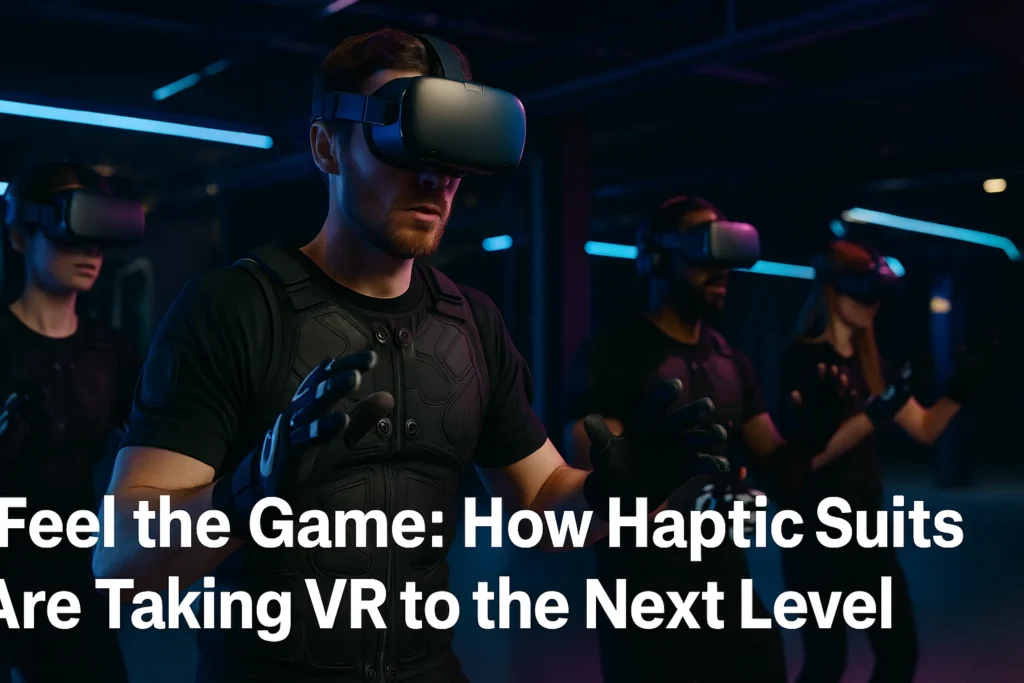Kenji braced himself, palms sweating slightly inside the sleek, black gloves. The virtual mountaintop stretched before him, icy wind whipping digital snow across his goggles. He took a step onto the narrow ridge. Instantly, a wave of vibrations surged through the soles of his boots, mimicking the crunch of gravel. A phantom gust of freezing air blasted his face, making him gasp. Then, the unthinkable happened – his foot slipped. As he plummeted in the VR world, a sudden, sharp pull cinched tightly around his waist, yanking him back with startling physicality. Kenji wasn’t just playing a climbing sim at Tokyo’s NeoVerse VR Arcade; he was feeling it. This is the revolution hitting VR Arcades worldwide: Full-Body Haptic Suits that simulate touch, temperature, and resistance, shattering the final barrier between the digital and the real.
Beyond Sight and Sound: The Haptic Tech Unleashed
Forget clunky vests that only buzz. The new generation of Haptic Gaming Suits is sophisticated wearable tech, transforming how players experience virtual worlds:
- Touch That Tells a Story: Hundreds of tiny actuators embedded in the suit fabric deliver precise vibrations. Feel the patter of virtual rain on your shoulders, the scrape of a zombie’s claws across your chest armor, or the delicate flutter of a butterfly landing on your hand. Companies like bHaptics and Teslasuit lead this sensory orchestra.
- Temperature Takes You There: Integrated thermo-electric modules create real hot and cold sensations. Experience the searing heat of a desert sun, the bone-chilling cold of deep space, or the sudden warmth of virtual blood splatter during combat. KOR-FX vests incorporate thermal elements, enhancing immersion dramatically.
- Force Feedback for Impact: This is where the magic of physical resistance comes in. Using strategically placed electroactive polymers or pneumatic systems, suits can simulate recoil from firing a heavy weapon, the pushback of ocean waves, or the jarring impact of a punch landing. Feeling the weight of a virtual sword block fundamentally changes combat games.
- Motion Capture Synergy: Suits often integrate with VR motion tracking systems, ensuring sensations align perfectly with your virtual body and actions. Step on a virtual landmine? The explosion’s force originates from your feet upwards.
The Arcade Revolution: Where the Suits Are Hitting Mainstream
While early prototypes were lab curiosities or prohibitively expensive, 2025 marks the true mainstream arrival in dedicated VR spaces:
- Asia Leading the Charge: Tech-hungry markets like Japan (NeoVerse, VR Park Tokyo), South Korea (Lotte World VR, VR Plus), and China (Sandbox VR locations) were early adopters. Arcades offer premium “Haptic Pod” experiences for popular titles, often charging a premium that gamers eagerly pay.
- North America Catching Up: Major chains like VR World NYC, The VOID locations (revived with new tech), and Sandbox VR across the US and Canada are rapidly integrating full-body haptic options. Even smaller boutique arcades are adding bHaptics Tactsuit lines.
- Europe Joins the Fray: High-end arcades in the UK (Otherworld, DNA VR), Germany (VRBase Berlin), and France (Illucity) are investing heavily, recognizing haptics as the key differentiator in a competitive market.
- The “Premium Experience” Model: Arcades typically offer tiered pricing. Basic entry gets you a headset and controllers. Pay more, and you step into the haptic suit – the difference in immersion is undeniable and driving repeat business.
Game Changers: Titles Transformed by Touch
The suits aren’t just tech demos; they’re elevating specific game genres:
- Combat & Horror Reimagined: Feeling every bullet impact, sword clash, or monster grab in games like Blade & Sorcery, Surv1v3, or Arizona Sunshine 2 adds visceral intensity and physical strategy impossible with controllers alone. Horror becomes genuinely unnerving when you feel the cold breath of an entity behind you.
- Sports Simulation Gets Real: Playing VR boxing (Thrill of the Fight) with haptics means feeling the jolt of a solid punch landing on your guard. Racing sims (Gran Turismo VR, Project Cars VR) convey G-forces and road texture. Archery (In Death: Unchained) lets you feel the bowstring tension.
- Adventure & Exploration Deepened: Climbing (The Climb 2) becomes a full-body workout when you feel every handhold and the pull of gravity. Exploring alien worlds or deep oceans is profoundly different when you sense environmental temperature shifts and physical interactions with objects.
- Social VR Gains Nuance: Future applications in social spaces like VRChat or Meta Horizon Worlds could allow feeling virtual hugs, handshakes, or environmental elements shared with friends, adding a powerful layer of connection.
The Appeal: Why Gamers Are Suiting Up
The surge in haptic suit adoption isn’t just novelty; it fulfills core desires:
- Unprecedented Immersion: This is the holy grail of VR. Feeling the virtual world physically tricks the brain more profoundly than visuals and sound alone, creating powerful “presence.”
- Enhanced Gameplay & Skill: Physical feedback provides crucial tactical information – the direction of an attack, the texture of a surface for climbing, the recoil pattern of a weapon – leading to more intuitive and skillful play.
- Emotional Amplification: Fear, excitement, awe, and tension are massively amplified by physical sensations. A jump scare isn’t just visual; it’s a physical jolt.
- The “Wow” Factor & Social Sharing: The experience is inherently shareable and impressive. Arcades thrive on groups wanting to try this cutting-edge tech together.
Facing Reality: Challenges on the Path
Despite the excitement, hurdles remain for widespread adoption:
- Cost Barrier (For Now): High-end suits like TESLASUIT are still significant investments for arcades ($1000s per unit). While consumer models like bHaptics are more affordable, the full-body experience with force feedback remains primarily an arcade luxury. Rental fees reflect this.
- The Hygiene Hurdle: Sharing suits in public spaces requires rigorous cleaning protocols. Arcades use disposable liners, advanced UV sanitization stations between sessions, and dedicated staff for suit maintenance – adding operational complexity and cost.
- Setup Time & Complexity: Donning a full haptic suit takes longer than grabbing a headset. Arcades need efficient processes to manage this and avoid long waits, especially during peak hours.
- Content Integration: Not all VR games support advanced haptics natively. Arcades often rely on middleware like Teslasuit’s TeslaStudio or bHaptics’ design software to map sensations for popular titles, requiring technical expertise.
- Bulk & Comfort: Even the most advanced suits add weight and can feel restrictive or warm during intense, lengthy sessions. Ongoing design focuses on lighter materials and better airflow.
- Safety Considerations: Force feedback needs careful calibration. Simulating a punch is immersive; dislocating a shoulder is not. Suits have safety limits, and staff must monitor users.
The Future Feels Tangible
The trajectory is clear: Haptic Suits are becoming the expected standard for premium VR arcade experiences. As technology advances:
- Costs Will Drop: Wider adoption and manufacturing scale will make suits more affordable for arcades and eventually consumers.
- Tech Will Miniaturize: Suits will become lighter, less restrictive, and faster to put on/take off.
- Fidelity Will Increase: More precise actuators, wider temperature ranges, and more nuanced force feedback will deepen immersion.
- Wireless & Standalone Integration: Future standalone VR headsets may incorporate more sophisticated built-in haptics, blurring the lines.
- New Genres Will Emerge: Games will be designed specifically around the unique possibilities of full-body haptic feedback.
Conclusion: Stepping Into the Sensation
Kenji finally reached the virtual summit. As he planted his flag, a wave of warmth spread across his chest from the suit’s thermal pads, mimicking the sun breaking through the clouds. He felt the vibration of the flagpole in his hands and the satisfying click through the gloves as it locked into place. Removing the headset back at NeoVerse, his muscles ached slightly from the climb – a phantom sensation from an intensely real virtual experience.
Haptic Gaming Suits are no longer science fiction. They are the pulsating heart of the next generation of VR arcades, transforming pixels into palpable sensations. They offer a glimpse into a future where we don’t just see and hear digital worlds, but feel them with our entire bodies. While challenges like cost and logistics persist, the sheer power of the experience is undeniable. For gamers seeking the ultimate immersion, stepping into one of these suits isn’t just playing a game; it’s stepping into the game, ready to feel every thrilling, terrifying, and exhilarating moment. The next level of VR isn’t just visual; it’s profoundly, undeniably physical.




e1yo3l